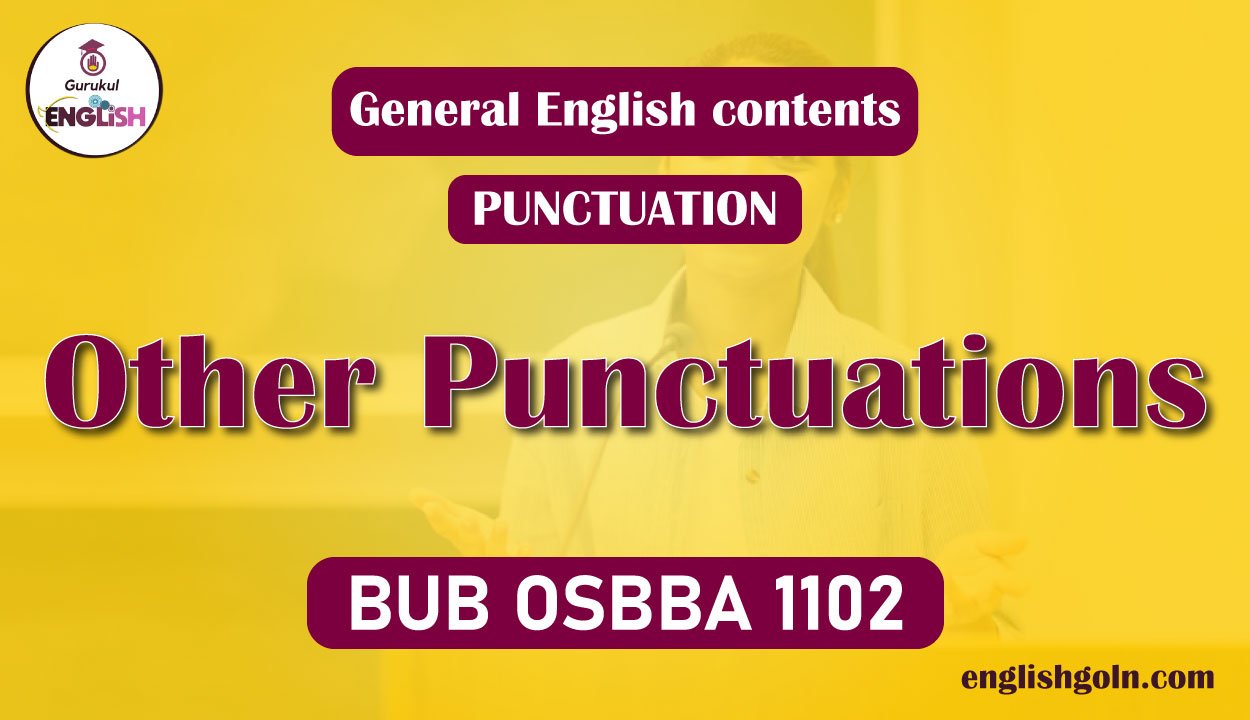Today is our topic of discussion – Other Punctuations
Other Punctuations

Other Punctuations
Quotations marks (” “) are a pair of marks which is used primarily to mark the beginning and the end of a passage attributed to another and repeated word for word. It is also used to indicate meanings and the unusual or dubious status of a word.
- “Don’t go outside,” she said.
Single quotation marks (”) are used most frequently for quotes within quotes. - Marie told the teacher, “I saw Marc at the playground, and he said to me ‘Bill started the fight, and I believed him.”
Parentheses, braces and brackets
Parentheses, braces and brackets are the symbols used to contain words that are a further explanation or are considered as a group. Parentheses (()) are curved notations used to contain further thoughts or qualifying remarks.
However, parentheses can be replaced by commas without changing the meaning in most cases.
- John and Jane (who were actually half brother and sister) both have red hair.
Braces ({}) are used to contain two or more lines of text or listed items to show that they are considered as a unit. They are not commonplace in most writing but can be seen in computer programming to show what should be contained within the same lines. They can also be used in mathematical expressions. For example, 2/1+ [23-3]) =x.
Brackets are the squared off notations ([]) used for technical explanations or to clarify meaning. If you remove the information in the brackets, the sentence will still make sense.
- He [Mr. Jones] was the last person seen at the house
Apostrophes
The apostrophe (‘) is used for several purposes, like-
- The marking of the omission of one or more letters (as in the contraction of do not to don’t).
- The marking of possessive case of nouns (as in the eagle’s feathers, or in one month’s time).
- The marking of plurals of individual characters (e.g. p’s and q’s).
Dash and the Hyphen
Two other common punctuation marks are dash and hyphen. These marks are often confusing to each other due to their appearance though they are very different in action.
A dash is used to separate words into statements. There are two common types of dashes: en dash and em dash.
- En dash: Twice as long as a hyphen. It is a symbol (–) that is used in writing or printing to indicate a range, connections or differentiations, such as 1880-1945 or Princeton-New York trains.
- Em dash: Longer than the en dash. It can be used in place of a comma, parenthesis, or colon to enhance readability or emphasize the conclusion of a sentence. For example,

She gave him her answer — No!
Whether you put spaces around the em dash or not is a choice of style. Just be consistent.
A hyphen is used to join two or more words together into a compound term and never separated by spaces.
For example: part-time, back-to-back, well-known etc.
Ellipsis
Often you see a sentence concluding with three dots, it indicates that only one part of the sentence or text has been quoted or that it is being left up to the reader to complete the thought.
As example:
- The Lord’s Prayer begins, “Our Father which art in Heaven…”
- He is always late, but you know how I feel about that….
Slashes
The slash is a punctuation mark used in English. An explanation of what a slash means in a text depends on the context. Slashes can mean many different things, depending on how they are used.
- To separate lines in prose
A slash can show a line break in a poem, song, or play; usually, if several short lines are being written together on one long line. For example: Mary had a little lamb/ little lamb, little lamb/ Mary had a little lamb.
- To indicate “Or”
Often, when a slash is used in a formal or informal text, it is meant to indicate the word or. The
examples below illustrates this meaning of the forward slash. When leaving the classroom, the teacher noticed that a student had left his/her backpack. If/when Mary ever shows up, we can all head out to the party together.

To denote dates and fractions
One of the most commonly recognizing usages of the forward slash is to indicate dates and fractions: ½
